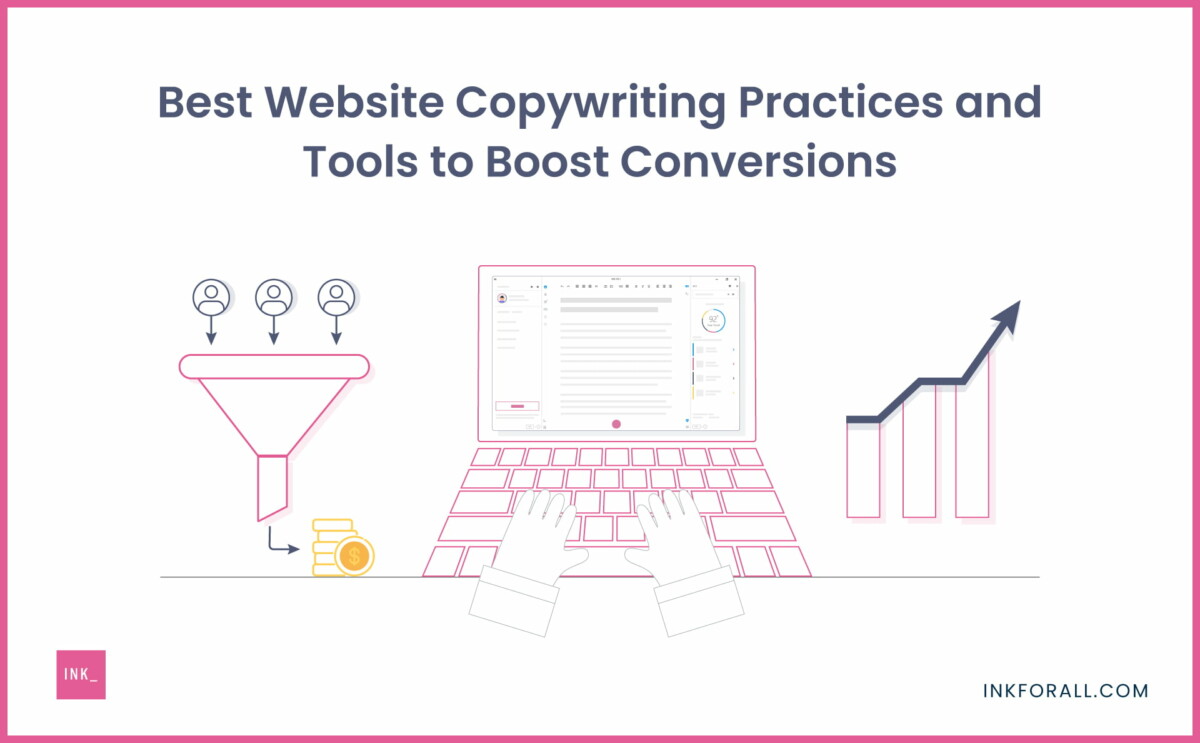
Are you looking at blogging as a way to promote your business? Do you want to improve your blog posts in a way that people actually get interested in your products and services after reading them?
Worry not because you have reached the right place! We are going to tell you all about the tips and techniques of copywriting for blogs.
Copywriting for blogs is different from your usual blog posts. The conventional style of blogging is closer to content creation; it focuses on providing the reader with information and insights.
It does generate sales but in a rather indirect way. Generating sales through conventional blog posts is a long-term process. In blog copywriting, you mean business.
The intent of your copy is to persuade the audience to sign up for your product or service.
We will tell you all about the tips and tricks for blog copywriting. But before that, let’s understand what exactly is copywriting for blogs.
What is copywriting for blogs?
Copywriting for blogs is the art and craft of promoting your business through blog posts.
A blog copy differs from an advertising copy; you are not directly advertising your products and services.
But you are nevertheless writing copy with the intent to sell. Copywriting is used by bloggers looking to monetize their content.
In this type of blogging, you write on the most sought-after topics related to your niche.
You provide the audience with informative and entertaining content, but your copy is ultimately leading the audience to concrete action.
Copywriting for blogs is blogging with a strong marketing motive.
If you are blogging without any concrete sales motive, your effort will go wasted, no matter how good your blog posts are.
Copywriting will give your blogs the required punch and precision to reach your target audience and ultimately persuade them to take action.
Great copy will direct the audience toward the relevant areas on the blogger’s platform such as a paid channel or web store.
Basics of Good Copywriting for blogs
What is good copywriting? Well, it could be subjective to an extent depending on your niche.
If you are writing for flamboyant niches like fashion and lifestyle, your approach would be different than let’s say if you are writing for a somber niche like medical services.
Still, there are some universal basics of good copywriting. These principles apply to all kinds of copywriting so you can specifically use them to hone your blog copy.
These are the 4 Us of copywriting that have been endorsed by the most famous copywriting professionals all over the world!
Let’s get to know them in detail.
1. Must be useful
You must make your blog post useful for the reader.
If you merely narrate your experiences, that wouldn’t have many takers. The secret of a good copy lies in connecting with the reader’s interests and providing them with the information they can find useful.
For example, if you write a blog titled, ‘ My Paris Visit’, would it get many takers? Probably not because your blog is highly vague and subjective.
But, if you rewrite the same copy with the title, ‘ 5 Tips for Solo Travelers visiting Paris’, the post would get many clicks.
The audience would now find your content useful. They can use this information while planning their own journey.
In other words, always look for pegs to help the reader relate to your experiences.
2. Must be unique
Great copywriting is offbeat, quirky, and playful. In other words, it’s unique.
Nobody wants to read the same kind of boring copy again and again. What do all great brands have in common?
They have succeeded in building a unique brand image distinct to them. You must strive to provide that unique and fresh perspective through blog copywriting.
Look for unique topics in your niche that no one has written about much. Even if you are writing on familiar topics, always provide a new twist.
Remember that the reader has limited time. They are more bound to stop at something that literally grabs their attention than stuff that is predictable.
3. Must be Urgent
You immediately think of a news headline upon hearing the word urgent.
But a blog post headline can be urgent too. Catch the audience’s attention with a dramatic headline that gives the impression they need to put aside all of their other cores to read this copy!
Urgency can be a good copywriting strategy.
You need to carefully construct a storyline using facts and figures that convinces the reader of the need for urgent intervention of your product or service.
However, the use of the trope of urgency depends on your area of expertise. You cannot utilize this strategy for all blog posts.
4. Must be ultra-specific
Copywriting is not generic. It is highly specialized and targeted writing with the intent of marketing your brand.
Keep your blog copy as specific as possible. Presume that whoever reads your blog will have a certain level of interest in your subject matter.
Your copy should not waste time beating around the bush and offer the reader concrete information.
They should be able to say that they learned more about a topic and the product than when they landed on your site.
Top tips for Blog Copywriting
Web copy has its own styles and conventions. Blog copywriting is different from content creation as well as traditional advertising copywriting.
You need to master the rules of web copy to ace copywriting skills for blogging.
Brevity is the soul of copywriting, even more so in online copy. The visual structure of your content is equally important.
Remember that the audience is reading your copy on the web so you must write accordingly.
Let’s check out some great copywriting tips for blog copywriters.
1. The Title is Everything in Copywriting
The title of your blog post is the first thing people view when they land on your page.
You must leave no stone unturned in making your title catchy and click-worthy.
The title of your blogging copy pretty much determines whether people will spend time on your blog. Writing a worthwhile title for a blog is a whole lesson in itself.
The trick to writing a good idea lies in teasing the audience a little bit.
The title should give the reader a taste of what the article will offer but not the complete picture. It should be a bit like the opening sequence of a suspense thriller!
Mastering the art of writing a good title requires some time and effort. You must research your niche thoroughly and then check out the titles of the best blogs on the internet.
By best, we mean the ones that are most popular and have actually managed to generate some serious business.
2. Rock your copy with a strong intro!
A copywriter must focus on the intro of their blog, the first paragraph that is.
Once the headline appeals to people and they start reading your blog, the first paragraph will be your litmus test.
If you manage to get them hooked on the intro, people will explore further and get as far ahead as reading your calls to action.
Copywriters could consider following the inverted pyramid structure in their blog. According to this writing structure, you move from the most important to the least important.
The first paragraph will have the meatiest bits – information that will engage people the most.
You could also start your blog with a welcome and tell your audience briefly why they are here and what they can expect to learn from this blog.
This gives the audience a clear set of expectations. After you’ve given them a bit of a tease, they are also more excited to follow your blog till the end.
In a nutshell, the intro of your blog should be
- Warm & conversational
- Informative
- Precise ( It should give people an exact sense as to why they are here and what would they achieve from reading this blog)
- Dramatic ( you need a bit of drama to grab the attention of your audience )
3. Short and snappy paragraphs
The art of brevity in copywriting becomes even more important when you are writing online content.
When the audience is reading content online, too much matter put together can be taxing for their vision and concentration.
You must break your content into many small chunks. Paragraphs should be extremely short. Aim for no more than 3-4 lines per stanza.
Short paragraphs give people a breather, and they feel like moving from one to the next. They also get time to process things and absorb the points.
Also, all your paragraphs should make sense individually.
Breaking content up into smaller chunks doesn’t mean you split it up anywhere.
The transition between paragraphs should be smooth. One point should lead logically to the next.
The art of writing short paragraphs will come with practice. Also, you should spend some time daily going through the content of famous bloggers and notice the structure of their copy.
Remember that online copywriting is very different from writing in print. You cannot copy the paragraph structure of a print article in writing a blog.
4. Limit it to one idea per sentence
Blog writing should be simple, concise, and precise. Do not confuse the audience with too many ideas.
Ideally, every sentence should have just one central idea, and the paragraph should carry forth that idea.
If you put too many ideas clubbed together, people will get confused, and your paragraphs will also appear vague.
If you need to talk about different ideas in the same paragraph, break up the idea into multiple sentences.
It is more visually appealing to the reader, and they would be able to understand your message much better.
The trick to mastering this technical feature of blogging is to start noticing the language structure and use of a blog. When you read something online, don’t pay attention only to the content. Observe the way sentences have been structured; paragraphs have been broken, etc. This would help you hone your own copywriting skills.
5. Use variations in text style to create tone
Reading the same kind of plain text throughout can be boring for the reader. Liven up things a bit by using a variation of bold, italics, and underlining.
Highlight important points of your blog in bold. Readers don’t have the time to go through the entire content. The bold highlights will let them skim through the text without having to read everything.
The use of italics can help you put extra emphasis on some points, and underlining can help reinforce a statement.
The idea is to constantly surprise the reader ( in a good way ) and keep them visually hooked.
In blogs, the visual look of your content is as important as the subject matter.
You could also consider using different highlights in different colors and fonts to emphasize your calls to action.
6. Leverage AIDA formula of copywriting
1. Leverage AIDA formula of copywriting
AIDA is a popular copywriting formula used by copywriters across different industries to get audience attention and boost conversions.
AIDA stands for Attention, Interest, Desire, and Action. These are the four stages through which you want your reader to go when they read your blog.
Attention
The first stage is attention. You must use a captivating headline to get the attention of the audience. One way to have an attention-grabbing headline is to look for common questions in your area of expertise and have the headline answer those. For example, if your niche is writing and people are doing a lot of Google searches on ‘ how to become a content writer’, then your article title could be 5 tips for beginners in content writing’.
Interest
The next stage is Interest which is the audience should get interested enough to know more about the subject.
Your opening paragraphs will take care of this bit. You need to cultivate the interest of your audience by telling them precisely how your content solves their problem. At this stage, you have to connect with the audience and relate your subject matter to their life goals and aspirations.
Desire
The next stage is desire. Now that you have the attention of your audience, you need to make them desire your service or products.
It is not an easy task. Mere facts and statistics won’t help. You need to use various emotional triggers and weave a storyline to make the audience fall madly in love with your offering.
It is at this point that you need to elaborate on your expertise and demonstrate to your audience why your services or products are better than those of your competitor.
Action
Action is the final stage of copywriting.
Now that you have induced in your audience a desire for your brand, you must persuade them to take action.
This is where you offer a strong call to action to initiate conversions.
It could be a website subscription, newsletter signup, or a direct purchase – any action that lets the reader become a tangible part of the sales cycle is a call to action.
7. Come to the main point quickly
You shouldn’t while away time beating around the bush in copywriting.
It is not like a feature article where you slowly build the mood and ambiance and then get to the point.
Blog copywriting is a great marketing tool and has to be structured like one. The reader shouldn’t discard sections of your blog as irrelevant. Every section needs to answer their questions in some way and solve their problems.
Avoid using fluff. When you go on writing for the sake of it using flowery language and empty words, the reader can see through your façade.
The language should be witty and conversational, but your content should be to the point. Being conversational doesn’t mean you can say just anything.
8. Engage your audience with a unique angle
You must find a unique angle for your blog.
There are too many clichéd blog posts out there that talk about the same thing over and over again. You don’t want to join that crowd.
Find a unique and fresh perspective.
One way of doing this is to focus on the best feature of your product and then weave a story around it.
Instead of talking about all your offerings in a generic way, concentrate on that one USP which will close the deal for the audience.
Copywriting is all about finding new angles. If you are writing content on a fairly common topic, try and explore it from a new point of view. Having a newsworthy angle always helps. If you can somehow connect your story to the latest news in your niche and explain the superiority of your brand from the news angle, that would be great.
So we’ve told you all about the tips for getting that perfect blog copy done! But you can implement these skills only if you spend some time honing your copywriting skills.
In the final section, we’ll give you tips to develop your copywriting skills.
Don’t forget to read our articles on How to successfully transition into copywriting. & Copywriting Secrets
Tips to hone your critical copywriting skills
• Research the brand – The perfect copy reflects the values and persona of the brand it’s about. You must research all about the brand you are writing for.
If you are copywriting a blog about your own business, you need to be clear about the vision and ethos of your business. All your copy needs to reflect a unified brand image. It can’t be contradictory.
• Study marketing language – Copywriting is all about marketing. The way the language is used is very different from your usual article writing.
You need to study different kinds of web copy to get a hang of marketing language. Also, you need to go conversational and colloquial so you need to be really creative and original with language use.
• Adapt the language to your brand image – This is most crucial. You must use language in a way that it matches your brand’s voice.
If you are writing blog posts about health and wellness, your language must reflect the unique ethos of this niche. You must also study your competitors from the health and wellness segment and see how you can use language more effectively.
• Learn as much as you can – Copywriting is all about updating your skills and learning constantly.
You can go for so many online copywriting courses from sites like Udemy and Coursera. You can also watch Youtube videos made by the top experts in copywriting and listen to their podcasts.
Lastly, one must never miss the chance to read a great book on copywriting.




